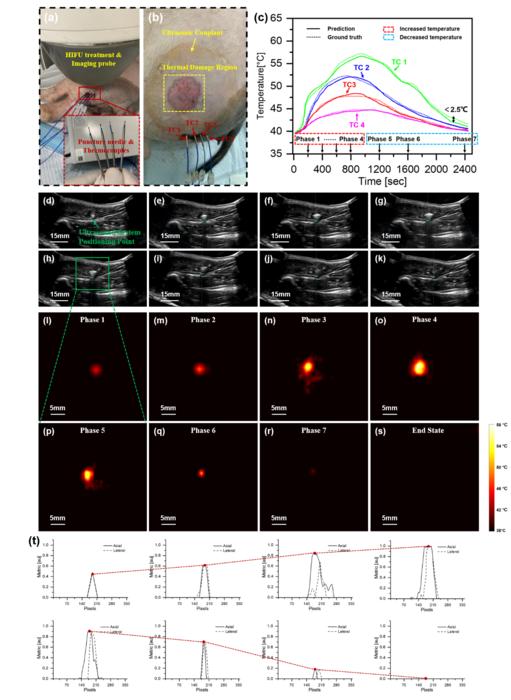
Real-time reconstruction of HIFU focal temperature field based on deep learning
HIFU is a non-invasive technique for tumor ablation. During the actual HIFU treatment process, biological tissues absorb acoustic energy and convert it into thermal energy. Measurement and control of tissue temperature within the HIFU focal region are crucial for the effectiveness of treatment. However, due to the heterogeneous nature of non-uniform biological media (including bone, muscle, fat, and blood vessels), which influence sound propagation and exhibit differences in acoustic absorption, it is currently challenging to achieve accurate and real-time monitoring of the temperature distribution within the HIFU focal region. As a result, it is difficult to plan effective ultrasound dosages (such as acoustic power and treatment duration) scientifically and precisely for patients. This, to some extent, affects the efficacy of HIFU treatments.

Credit: School of Integrated Circuits @ HUST.
HIFU is a non-invasive technique for tumor ablation. During the actual HIFU treatment process, biological tissues absorb acoustic energy and convert it into thermal energy. Measurement and control of tissue temperature within the HIFU focal region are crucial for the effectiveness of treatment. However, due to the heterogeneous nature of non-uniform biological media (including bone, muscle, fat, and blood vessels), which influence sound propagation and exhibit differences in acoustic absorption, it is currently challenging to achieve accurate and real-time monitoring of the temperature distribution within the HIFU focal region. As a result, it is difficult to plan effective ultrasound dosages (such as acoustic power and treatment duration) scientifically and precisely for patients. This, to some extent, affects the efficacy of HIFU treatments.
In a recent work published in BME Frontiers, a HUST research team developed a deep Multi-Modal Teacher-Student (MMTS) approach, which enables real-time reconstruction of the HIFU focal temperature field. During HIFU treatment, the research team uses the ultrasonic diagnostic system to acquire ultrasonic echo signals and uses the temperature detection system to acquire real-time temperature data. They further trained a deep neural network that rapidly transforms B-model ultrasonic images into 2D temperature images, revealing accurate color and contrast. This reconstruction process takes only a few milliseconds per frame and does not need expensive computing resources. Using only a computer, the reconstruction of the HIFU focal temperature field could be accomplished much faster and cost-effectively, enabling more accurate dose planning.
The physicians from HIFU Center of Oncology Department, Huadong Hospital Affiliated to Fudan University validated this AI-based temperature reconstruction technique in terms of both its reconstruction speed and reconstruction quality. The physicians confirmed that the deep learning-powered temperature reconstruct approach effectively monitored the distribution of the HIFU temperature field in real-time, laying a theoretical foundation for subsequent personalized treatment dose planning, and providing efficient guidance for non-invasive, nonionizing cancer treatment.
This research was led by Dr. Benpeng Zhu, Professor for School of Integrated Circuits, HUST. Dr. Shunyao Luan, School of Integrated Circuits, HUST, in collaboration with Hong Zhao, Director of HIFU Center of Oncology Department, Huadong Hospital Affiliated to Fudan University. The other authors of this work include Yongshuo Ji, Yumei Liu, Linling Zhu, Haoyu Zhou, Jun Ouyang, and Xiaofei Yang.
Journal
BME Frontiers
DOI
10.34133/bmef.0037
Method of Research
Experimental study
Article Title
Real-Time Reconstruction of HIFU Focal Temperature Field Based on Deep Learning
Article Publication Date
21-Mar-2024